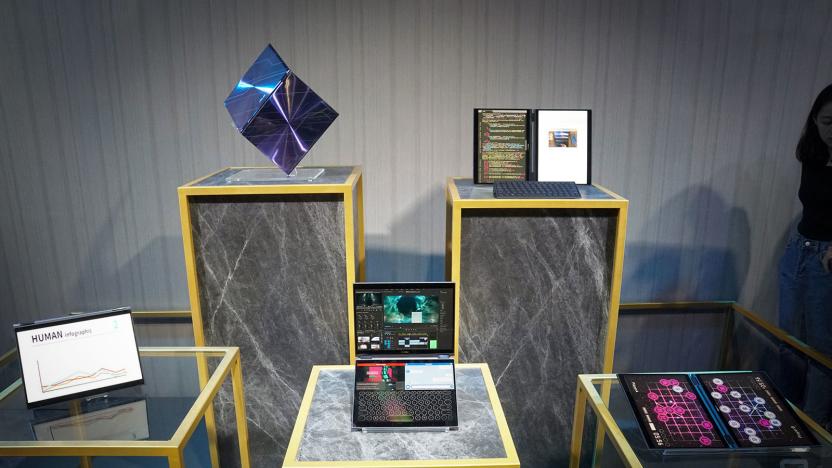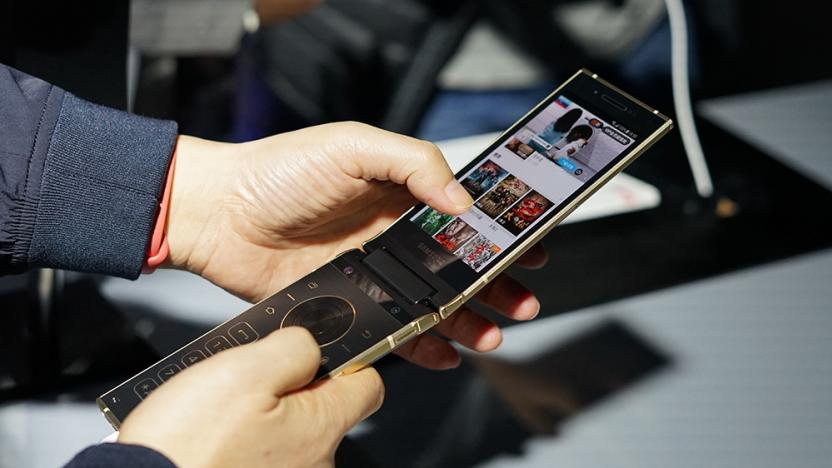dualscreen
Latest

LG’s G8X ThinQ Dual-Screen is a multi-screen compromise
The rumors both are, and aren't true. LG has built a dual-screen smartphone that drops around the same time as Samsung's Galaxy Fold and Huawei's Mate X. But it hasn't, because it's an upgraded G8 with a secondary display case similar to what we saw on the V50 ThinQ. Will this mix of flagship specs and a quirky screen case be enough to tempt you?

Samsung imagines a wraparound smartphone display
If that whole folding smartphone thing doesn't work out, Samsung has lot of other ideas cooking. It recently received patent approval for a continuous display that covers the front, while folding around the top and part of the rear of the phone, as spotted by Let's Go Digital. That would make for some interesting applications, like letting subjects see how they look before you take a photo or showing live language translations on the rear display.

Vivo's all-screen NEX goes dual-display to ditch the pop-up camera
While Vivo is still a largely exotic brand for many of us, you may remember it as the first manufacturer to both tease and release a truly bezel-less smartphone. And of course, Vivo's NEX S gained extra street cred thanks to its pop-up selfie camera plus in-display fingerprint reader. Just months later, the Chinese company is back with a follow-up model dubbed NEX Dual Display Edition, and as the name implies, it packs a screen on both sides of the phone, just so that it can ditch the pop-up camera -- a cool but physically vulnerable feature -- while still avoiding the notch on the main screen.

Nubia X avoids a notch by adding a rear display for selfies
While local competitors like Vivo, Oppo, Xiaomi and Honor have been trying various sliding mechanisms to achieve all-screen, notch-free smartphone designs, Nubia decided to take the easy approach: Getting rid of the front cameras and forcing you to use the rear cameras for selfies. This is why the freshly-announced Nubia X is a dual-screen flagship smartphone, with its 6.26-inch FHD+ LCD covering almost the entire front side, and the back featuring a smaller 5.1-inch 1,520 x 720 OLED panel to go with the dual cameras. A bit like Yota's implementation, except it's OLED instead of E Ink on the back; plus no front cameras, of course.

We have questions about dual-screen laptops
At Computex, ASUS and Intel showed off what they think could be the future of computing: true dual-screen laptops. Open up what's currently called Project Precog, and all you will see are two panes of glass that can be used in a variety of ways. It's a laptop! It's a dual-screen desktop! It's a lay-flat tabletop machine for board games! And that's not all, because you can use it in tent mode to show two things off to two people at once.

Samsung's W2018 flip phone has a variable aperture camera
Smartphone makers are always pushing for the fastest-possible camera aperture, and until today, the record was held by LG V30 with its f/1.6 lens. But it didn't take long before Samsung hit back with an even lower f-stop. Earlier today, the Korean giant announced the W2018 which is its tenth extravagant dual-screen flip phone -- likely priced at above $1,500 -- made exclusively for China Telecom's "Heart Of The World" charity series. To our surprise, rather than simply repackaging existing flagship components into this form factor, Samsung actually threw in some new tech this time: not only does its 12-megapixel main camera come with an even lower f/1.5 aperture, but it can also switch to f/2.4 for a deeper depth of field when lighting is ideal.

ZTE Axon M hands-on: A new hope for dual-screen phones
Many companies have tried to make the mythical dual-screen folding smartphone a reality. All of them have failed. But ZTE thinks it's time to try again. Now that Android supports multi-window apps, the company expects it will get enough buy-in from developers to create a phone that people will actually find useful. The Axon M will be an AT&T exclusive when it arrives in the US next month for 30 monthly payments of $24.17. I tried out the Axon M and while I'm not completely won over by the handset itself, I find the potential applications compelling.

Dual-screen Yota3 is official with a sharper E Ink screen
Well, the wait is finally over. After a teaser back in June, the third-gen dual-screen YotaPhone -- now simply dubbed Yota3 -- was unveiled in China yesterday. Pretty much all the main specs are identical to the leak Engadget received earlier, but this was our first time seeing this rounded metallic design. First and foremost, there's a 5.5-inch 1080p Samsung AMOLED screen along with a 13-megapixel f/2.2 camera plus a fingerprint reader on the front. Flip the device around and you'll see its headlining feature: a 5.2-inch 720p E Ink Carta II display -- an expected upgrade from the previous 4.7-inch 960 x 540 screen -- accompanied by three capacitive navigation buttons at the bottom.

LG's V30 flagship leaks in hands-on footage
Last month, LG teased a reveal for its V30 smartphone, a followup to its audiophile-friendly V20. While renders immediately appeared supposedly showing the upcoming phone's design, we might have just gotten a real leak. A user on Joseph Gordon-Levitt's creative repository HitRecord posted a few photos prominently featuring a phone with the V30 logo displayed on its back side. Intentional leak or not, the source video has been wiped from the internet -- except for the screengrabs Gizmodo took.

'YotaPhone 3' isn't the dual-screen powerhouse you were expecting
If you're one of the few people who are still waiting for the next dual-screen YotaPhone, listen up: we finally have an update for you. During Harbin's China-Russia Expo over the weekend, Baoli Yota -- the joint venture formed by investor Baoli (formerly known as REX) and manufacturer Coolpad -- teased its upcoming "Yota3" with a date: it's due in the early fall later this year (almost four years since the launch of its predecessor) and will come with 64GB or 128GB of storage for a more favorable $350 or $450, respectively, according to RBC.

Dual-screen YotaPhone 2 arrives in Europe this month
Yota was slightly cruel to YotaPhone fans. It unveiled the next generation of its dual-display smartphone way back in February... and left people wondering about the launch window for most of the year. At last, though, you can try this two-screened device for yourself. The YotaPhone 2 is now slated to launch in Europe this month for 32,990 rubles in the company's native Russia, or about $612. The hardware hasn't changed much since the start of 2014, which makes this a mid-range device with a few tricks up its sleeve. You're still looking at a 5-inch 1080p AMOLED display at the front, and that signature 4.7-inch e-paper touchscreen at the back for basic tasks and alerts; inside, there's a respectable Snapdragon 800 processor, 32GB of storage, an 8-megapixel rear camera and a 2-megapixel front shooter.

Hands-on with the YotaPhone: the e-ink Android phone that nobody expected
There was a moment, back in 2012, when we had some quiet doubts about the YotaPhone. The first prototype was desirable, useful, and far beyond any kind of gimmick -- but it also seemed like it'd be hard to manufacture for a reasonable price, especially by a company that has never built a phone before. After all, this is effectively two devices rolled into one: an LTE Android phone with a 4.3-inch LCD display on one side, plus an e-reader on the other side, offering always-on notifications from the OS and the luxury of over 60 hours of e-book reading time thanks to good old E Ink technology. Fortunately for us, and for any other phone lover on this planet who appreciates fresh ideas, such fears were unfounded. The Russian engineers at Yota Devices have overcome the many technical challenges that stood in their way, and the fruit of their efforts will go on sale in Europe later today via a dedicated online store, priced at a not-so-wacky 499 euros ($675). Admittedly, that may seem like a lot to ask if you focus solely on the specs -- like the 720p resolution of the LCD or the mid-range Snapdragon S4 Pro processor -- but it starts to make sense when you take a look at just how unique this thing is. And now that we're holding the final hardware in our hands, we're able to do just that.

Samsung Hennessy is official: a dual-screen flip-phone with a quad-core CPU
While we'd like to feign surprise at Samsung's official reveal of another dual-screen Android flip phone, yesterday's leak gave us ample warning. Samsung's Chinese website has officially outed the Hennessy (W789), and it boasts a pair of 3.3-inch 320x480 touch displays and runs Android 4.1 on a 1.2GHz quad-core CPU. The outer screen is bordered by a trio of capacitive keys, allowing folks to zip through Google's OS, as per usual. When it comes to other internals, the hardware packs a 1,500mAh battery, microSD slot, 5-megapixel rear camera and dual SIM support for CDMA and GSM radios. Naturally, the hardware also includes GPS and connectivity over Bluetooth and WiFi. Word on a release date, pricing or whether the device will see other territories still hasn't surfaced, but its GSM compatibility may inspire hope that imported units could work stateside. Now that the Hennessy has made its debut, it can't be long before the curtains are pulled back on the leak-prone Galaxy Folder.%Gallery-195954%

HTC patents a dual-screen slider phone that you likely won't see
While HTC is certainly willing to accommodate multiple screen sizes and form factors with its phones, we suspect that some of its explorations won't go beyond the lab. If you'd like an example, see the company's newly obtained patent for a dual-screen slider design. Oh, it's clever: the mechanism gracefully moves a hidden second screen into place, tilting the unfolded arrangement to form one united display area. Like with other dual-screen patents, we're skeptical simply because of market realities. HTC's rocky financial position doesn't give it much room to take risks, and dual-screen phones need special software support that often makes them non-starters -- just ask any Kyocera Echo owner how that developer program is panning out. As a result, it may be more accurate to call the patent a vision of what might have been than any kind of roadmap.

BlackBerry patent application shows the dual-screen phone that thankfully never was
Going dual-screen is really the nuclear option for smartphone design -- it's what you use to draw attention when your regular, single-screen phones aren't thriving. We're at once unsurprised and appreciative, then, that BlackBerry has applied for a patent on a dual-screen phone concept that hasn't gone further than a filing. As shown, it would embrace the familiar concept of running separate apps on each screen, with a slight twist: it could recognize touch gestures that span both displays, such as a pinch to switch app positions. Naturally, it could recognize distinct gestures on only one side or put a keyboard on one display for typing on the other. Given BlackBerry's current design directions and very different gesture concepts, the application is more of a what-might-have-been than any kind of roadmap. It's just as well when many twin-screen smartphones haven't exactly panned out.

NEC's Medias W global prototype spotted: 4.3-inch Android phone or 5.6-inch tablet? (hands-on)
NEC will launch its dual-screened Medias W in Japan in April, but now the company is working to get the phone landing in shores beyond Nihon. We saw glimpses of the red-finish global prototype that's on show here at MWC, although the company wasn't able to confirm any prices or destinations for the worldwide versions just yet. We also managed to get to grips with the Japanese iteration. Fortunately the only difference between the two models is NTT DoCoMo's baked-in proprietary apps and menus. So that's less bloatware? Count us in. We've got more impressions the on the dual 4.3-inch phone (and our hands-on video) right after the break.

NEC's Medias W unveiled: a folding smartphone with two 4.3-inch displays
Japanese carrier NTT DoCoMo just outed its spring lineup of handsets, and the Medias W N-05E caught or eye, just like it did as a hollow mockup at last year's Mobile World Congress. The NEC-made handset has gone from a mere plastic shell to an LTE-wielding phone with a pair of 4.3-inch LCD displays (each 540 x 960 in resolution), a 1.5 GHz dual-core processor, 1GB of RAM, an 8-megapixel shooter, 16GB of built-in storage and a microSDHC slot. When open, the device serves up roughly 5.6 inches in diagonal screen real estate, and measures up at 64mm in width when shut. Thanks to the nature of the dual-screened beast, apps can use each screen independently or together to provide more space. Despite the Jelly Bean-toting rig's penchant for going over the top, it leaves out NFC and Japan-centric digital TV tuner functionality. The smartphone is slated for an April release with an unspecified price tag, but there's no word on availability in other territories.

YotaPhone Android prototype with dual LCD and E Ink displays hands-on (video)
Yesterday we brought you the announcement, and today we bring you the hands-on reality -- although bear in mind that this dual-screen YotaPhone is still very much a prototype. It certainly works -- pretty well, in fact -- but it's understandably rough around the edges and Yota Devices have plenty of work to do before the handset launches towards the end of next year. By way of a quick refresher: from the front this is a regular Android Jelly Bean phone with decent specs, including a 720 x 1,280 LCD display, dual-core 1.5GHz Snapdragon S4 processor, 2GB of RAM and a 12-megapixel main camera. Turn it around, however, and you reveal its double identity: a 200 dpi E Ink display which can hold a range of information -- calendar appointments, ebooks, tweets and whatever else you'd like -- without draining the battery. The good new is that the YotaPhone actually makes an even better first impression than we'd hoped, while the bad news is merely what's to be expected given the early stage of development. Click past the break for our hands-on video and impressions and all will become clear.

Russian YotaPhone promises dual 4.3-inch LCD and E Ink displays in Q3 of next year
Cast your mind back to IFA and you might just recall the appearance of a dual-screen mash-up device with no proper branding or launch date. Well, it so happens we've been in touch with the mystery phone's maker, Yota Devices -- a spin-off from the more established Russian telecoms company of the same name -- and we're assured that this is much more than a whimsical concept. The Android-based handset has now reached fully working prototype stage and bears a Gorilla Glass 4.3-inch 720 x 1,280 LCD display on the front, a 200dpi E Ink rear display of the same size and toughness, and a dual-core 1.5GHz Snapdragon S4 processor with 2GB of RAM and at least 32GB of non-expandable storage. There's even LTE, a 12-megapixel rear camera and a 720p front-facer to round things off, all housed in a 140 gram body that is less than 10mm thick. If things go to plan, the YotaPhone should arrive on Russian networks in Q3 of next year for an untold sum of money, and Yota says it's "in talks" with certain US and European carriers too. Read on for more.

Switched On: The Three Cs of Wii U
In the pre-post-PC era, life was simpler for Nintendo and other successful competitors: Sell console. Sell discs. Repeat until wildly profitable. Six years ago, as Microsoft and Sony were taking part in a game of specification leapfrogging, Nintendo embraced casual and family gaming with the Wii even as it mostly ignored online play and convergent entertainment features. More than half a decade later, Sony has surpassed the original Wiimote with its Move controller and Microsoft has created a motion anti-controller with Kinect, but the Wii retains an advantage in that developers can assume the motion control is there. More Info Nintendo Wii U vs. Nintendo Wii: fight! Real Racing 2 HD beats Wii U to the wireless, dual-screen gaming punch Sony's Wonderbook is PS Move-augmented reading, launches with J.K. Rowling's 'Book of Spells' Today, everyone in the games business still adheres to the basic notion of compelling software selling hardware, but the source of that software and the manner through which it drives revenue has changed via models such as digital distribution, downloadable content, free-to-play, subscription and advertising. In addition, Nintendo has launched the Wii U into living rooms in which game consoles must compete not only with each other but with Blu-ray players, TiVos, Rokus and Apple TVs for physical connections as well as smart TVs and tablets as other sources of connected entertainment experiences. How it has addressed these challenges reveals much about what the company has held dear from the Wii, what it has reluctantly accepted and what it has now embraced.








